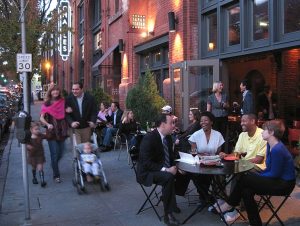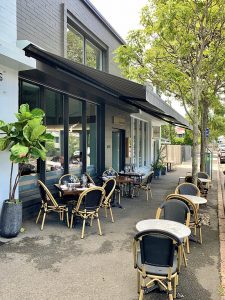COVID-19 has changed the way we all live, socialize and interact with one another. Since March, when Gov. Andy Beshear first closed all non-essential businesses, many industries have taken it on the chin. Restaurants have been affected greatly and many have declared bankruptcy or closed for good.
Then, just when the orders were lifted and restaurants were allowed back to 50 percent capacity in late June, a new surge in COVID-19 cases forced the governor to lower capacity back down to 25 percent just last week. Only time will tell just how many of these restaurants will survive or not in an already oversaturated market before COVID-19 hit.
Like any other industry, it comes down to the survival of the fittest, and he who has the best product, service, and the least amount of debt will outlast this pandemic and be standing when all the smoke clears.
The fact is, restaurants are low-margin businesses even when dining rooms can be filled to maximum occupancy. But now restaurants must operate with reduced capacity — making it difficult at best.
To survive, many restaurants have had to re-invent their operations. Many have focused revamping and increasing their order-to-go option for their clients, which was a mix of takeout, curbside and delivery. Some restaurants have even diversified and began to stock up and offer groceries and pantry staples to supplement their earnings.
As the number of COVID-19 cases mounted and restaurants pivoted to takeout, local governments also tried to help keep them open by easing rules on selling to-go alcohol and classifying them as essential businesses. As for many restaurants, alcohol sales are their most profitable item on the menu, so many restaurants started to sell mixed drinks to go as well.
However, while many restaurants have remained open the revenue stream is nowhere near enough to sustain the cost of doing business. To offset the decline in the number of seating offered to the public, many restaurants moved to outdoor dining in their parking lots and erected tents, while others have been granted outdoor seating for sidewalks and curbside seating that extend into the street.
As an entrepreneur minded-person myself, I applaud their necessity and creative thinking that went into such a decision. But as a safety and risk management professional, when you mix vehicular traffic into a casual dining environment, this is where my antennas go up.
In New York City alone, where there are 8,000 miles of streets, 8,600 restaurants and bars that serve food have been granted outdoor seating permits for sidewalks and curbside dining.
Many restaurants are now being allowed to set up dining not only on sidewalks, parking lots and patio seating, but into adjacent parking spots on the side of the roads. Many cities across the country are letting restaurants expand dining services to keep tables 6 feet apart, while still complying with state-level orders to reduce the seating capacity.
Like with every new problem solved, you often create a new hazard and in this case customer safety are being compromised. Unfortunately, the focus on safety has been directed to social distancing, using disposable utensils, mask-wearing, disposable menus, wearing gloves while serving the food, and disinfecting when patrons leave.
However, there is very little attention is being given to the elephant in room, and that is the exposure to moving traffic just a few feet away from unsuspecting patrons.
When viewing pictures of many of these setups for outdoor dining options, it scares me. Especially when you consider that in many of these situations, the guest is dining a few feet away from hundreds if not thousands of moving missiles weighing thousands of pounds traveling 25-45 MPH.
Recently, there have been several cases in which drivers have crashed through many of these makeshift seating areas since the return of outdoor dining. Just a few days ago in Brooklyn, a 2005 Ford pickup truck rammed into the seating barriers, throwing diners, tables, and chairs to the ground injuring three people, none severely. In this case, the restaurant had built what appeared to be wooden barriers in the street where the parking spaces once were located but were no match for the pickup truck.
 Keven Moore works in risk management services. He has a bachelor’s degree from the University of Kentucky, a master’s from Eastern Kentucky University and 25-plus years of experience in the safety and insurance profession. He is also an expert witness. He lives in Lexington with his family and works out of both Lexington and Northern Kentucky. Keven can be reached at kmoore@roeding.com
Keven Moore works in risk management services. He has a bachelor’s degree from the University of Kentucky, a master’s from Eastern Kentucky University and 25-plus years of experience in the safety and insurance profession. He is also an expert witness. He lives in Lexington with his family and works out of both Lexington and Northern Kentucky. Keven can be reached at kmoore@roeding.comAccording to Rob Reiter co-founder of Storefront Safety Council, which I am an adviser to, “We have more than 3,400 incidents in our database of vehicle-into-restaurant crashes, several hundred of which involve injuries and loss of life to patrons seated outdoors. We expect that we will see an increasing number of incidents involving injuries to outdoor dining patrons in the months to come as a result of the unsupervised manner in which permits have been issued for curbside or sidewalk dining in cities and towns all over the country.” Additional stats can be found at www.storefrontsafety.org.
Restaurants are critical to the vibrancy of their urban core and I applaud the effort for all these city officials and restaurateurs for thinking outside the box. However, safety must remain the priority for the patrons that are dining in these parking lots, sidewalks, and curbside outdoor dining areas.
City officials need to take a closer look at these set-ups and close an entire street during prime evening hours to eliminate the exposure entirely. Many cities like Cincinnati, New York, Tampa, Atlanta, and Boston have done just that, while some have just restricted parking or only reduced lanes.
If full street closure is not possible, then they should look to erect concrete construction barriers or heavy-duty safety rated decorative concrete planters that are designed to prevent vehicle ramming incidents. At the very minimum, they should look to lower speed limits and install temporary speed bumps to reduce the speed of the traffic traveling through these congested streets.
Safety must be at the forefront of this innovation and patrons must be kept safe. In a blink of an eye a driver could be distracted, overcorrect their steering, have a medical condition and lose consciousness, or just lose control of the vehicle and kill a dozen people within seconds.
For the sake of safety, I would encourage restaurant owners and all local governments to carefully weigh in all options to better protect patrons visiting restaurants with outdoor dining options.
Be safe, my friends.

























I like how you mentioned how local restaurants moved to outdoor seating and curbside delivery. My brother will be in town this weekend and I want to take him to some of the best local eating spots in my city. I’ll have to check which ones allow for dining in before making a decision.